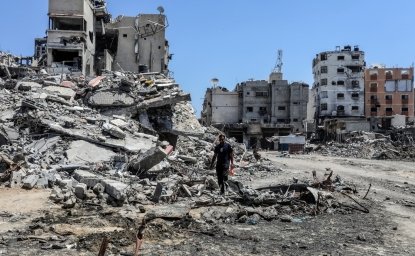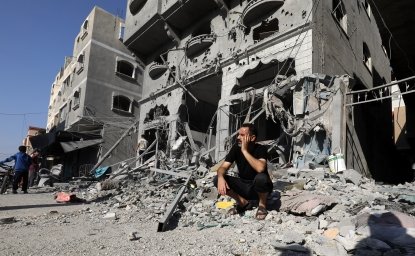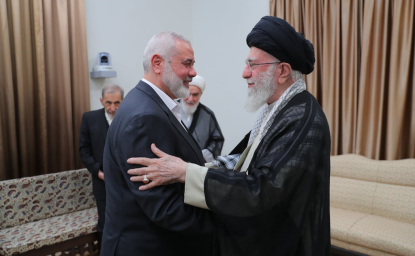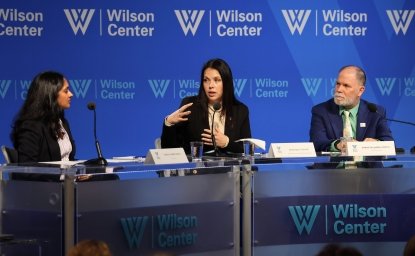By Robin Wright
Islamists have produced tectonic political shake-ups across the Middle East, with a rippling effect world-wide. Islamists now take many forms, from moderates in Tunisia to militants in the Islamic State. Together, the disparate factions have arguably altered the Middle East more than any trend since the modern states gained independence over the past century. They have redefined politics and even borders.
The turmoil and transformation have in turn redefined security challenges for the outside world too. In early 2015, Americans overwhelmingly—by 70 percent--identified the Islamic State as the main threat to the United States, according to a poll by the University of Maryland. The next two top threats—the Palestinian-Israeli conflict (13 percent) and Iran (12 percent)—also involved Islamist movements.
Islamism is now one of the most powerful forces of the 21st century.
By 2015, Islamists generally fell into two broad camps: Political parties vying for position within systems. And extremists using violence or waging war to change the system from outside. Some factions have tried to be both. But by 2015, political groups and extremist militias have also become rivals for influence, and sometimes even enemies.
The Beginning
The first Islamist movement actually goes back almost a century. Islamism evolved in five phases. It has not been a straight trajectory. Each phase reflected the scope of change in size, political purpose, priorities, and tactics.
Modern Islamism originally emerged in response to multiple crises in the vacuum created by the Ottoman Empire’s collapse and as an alternative to the dominant ideologies of either East or West. Often in the context of European colonialism, Islamist leaders argued that the outside world was out to exploit, control, or destroy Muslim lands. The only way to defend the faith was to fight back, politically, socially, and physically.
Modern Islamism began with a tiny cell in 1928, when a twenty-two-year-old schoolteacher mobilized six disgruntled workers from Egypt’s Suez Canal Company. It was originally a social and religious movement. But Hassan al Banna’s little group grew into the Muslim Brotherhood, the first popular Islamist movement in the Arab world. It eventually spawned more than eighty branches worldwide.
The Brotherhood created the start-up model that initially focused on fusing Islam with public services, such as schools, clinics, cooperatives, social clubs, welfare providers, and religious support groups. The public services evolved into mini-states-within-states, taking on distinct political agendas for changing the rest of society too. Many other Islamist movements later duplicated the formula.
The first phase peaked in the 1970s, as secular ideologies failed to deliver. The turning point was the 1973 war, when Arabs fought for the first time in the name of Islam. Egypt’s attack on Israel was code-named Operation Badr after the Prophet Mohammed’s first victory in 623 AD. The Arabs again lost militarily, but they won political goals, including the principle of land for peace. Islam became a winning way to mobilize the public and fight a regional war.
By 1979, Islam also redefined regional politics. Iran’s fiery revolution coalesced disparate opposition groups under the banner of Islam. Led by a septuagenarian cleric, the coalition ended dynastic rule dating back more than 2,500 years and then created the world’s only modern theocracy. For the first time since the faith was founded fourteen centuries earlier, clerics ruled a state. Islam was suddenly a modern political alternative, too.
The seizure of Saudi Arabia’s Grand Mosque by a fundamentalist cell reflected the growing rejection of modernization based on Western ways, which had been the model in many countries since their independence decades earlier. During the two-week takeover, extremists declared the monarchy to be illegitimate. They proclaimed the rule of the Mahdi—the Muslim redeemer—until French forces were brought in to help retake Islam’s holiest shrine.
The drama led regimes across the region to redefine modernization in more Islamic terms. Shaken to the core, Saudi Arabia’s monarchy ceded greater ground to Wahhabi clerics. Even strictly secular regimes reacted. Under President Sadat, Egypt altered its constitution to ensure that Sharia, or Islamic law, was the basis of all legislation.
The second phase played out in the 1980s. It witnessed the rise of suicide extremism and mass violence. The trend started among Shiites, for whom martyrdom has been a central tenet for fourteen centuries. It soon spread to Sunni militants, for whom it was not a long-held belief. The violent tactics by religious extremists began to redefine modern warfare.
The embryonic cells of Lebanon’s Hezbollah initiated suicide bombings with attacks on American and Israeli targets in the early 1980s. As of early 2012, the largest single loss of U.S. military lives since World War II was still the Hezbollah bombing of the Marine peacekeepers’ barracks in October 1983 that killed 241. Two American embassies in Beirut were also destroyed, as were several military facilities of the occupying Israeli Defense Forces.
Among Sunnis, two militant movements seized the headlines away from the Palestinian Liberation Organization, an umbrella group for several secular factions. Islamic Jihad was launched in the early 1980s. Its manifesto called for elimination of the “Zionist entity” and creation of a Palestinian state governed by Islamic law. It dispatched dozens of human bombs against Israeli soldiers as well as civilians. Hamas emerged in 1987 during the grassroots uprising known as the Intifada, literally the “shaking off.” Hamas, too, soon started dispatching suicide warriors.
Throughout the 1980s, thousands of Sunnis from all twenty-two Arab nations also poured into South Asia to challenge the Soviet Union’s occupation of Afghanistan. It was the first modern militant jihad. Many of these militant Arabs, including Osama bin Laden, later took their skills and passions home to launch local jihads.
In all three cases, militant groups justified violence as a response to intervention by outside armies or occupation by foreign powers. Again, from their perspective, violence was a reaction. The 1980s was a particularly deadly decade.
The third phase was marked by the rise of Islamist political parties in the 1990s. The emphasis shifted from the bullet to the ballot—or a combination of the two. Islamists began running within political systems, no longer simply sabotaging them from the outside. In the process, Islamists had to move beyond simplistic slogans to develop multi-issue action agendas.
Algeria was the trailblazer in 1991, as the Islamic Salvation Front began to beat more than fifty parties in the Arab world’s first fully democratic election. The Front was seen as a party of doers, in contrast to the corrupt and lethargic party that had ruled since independence three decades earlier. The experiment was derailed before the final runoff in 1992, when the Algerian army seized power. Backed by tanks on the streets of Algiers, the new junta nullified the vote, outlawed the Front, and imprisoned its leaders. An underground militant faction, the Armed Islamic Group, soon launched attacks on government targets. Over the next decade, more than 100,000 Algerians died in a civil war between the military regime and extremists.
Yet Islamic parties elsewhere continued the experiment, further spurred by two global shifts: The Cold War’s end altered the balance of power in the Middle East—and political calculations in the process. The first wave of democratic elections elsewhere—which empowered hundreds of millions of people, from Russia to Romania and from South Africa to Chile—inspired pursuit of individual empowerment.
In 1992, after a decade underground, Hezbollah’s Hassan Nasrallah led the Shiite party into Lebanese elections. Egypt’s Muslim Brotherhood ran for parliament in 1995, after a decade of competing under cover of other political parties. Jordan’s Islamic Action Front became the largest opposition party elected to parliament. From scenic Morocco and sleepy Kuwait to teeming Yemen, Islamist parties captured the imagination of many voters.
The fourth phase began after al Qaeda’s attacks on September 11, 2001, which were as traumatic for many Muslims half a world away as for Americans who witnessed attacks on the World Trade Center and the Pentagon. In the Arab world, hundreds of millions found themselves tainted by a man and a movement they neither knew nor supported.
Muslims were also increasingly victimized, as extremists expanded their suicide attacks from Morocco on the Atlantic to Saudi Arabia on the Persian Gulf. Almost 3,000 people died on 9/11, but militants killed more than 10,000 of their brethren in suicide bombings and other attacks over the next decade. The extremist strategy backfired. In Arab eyes, the many forms of militancy proved costly, unproductive, and ultimately unappealing.
“Every mother in Saudi Arabia or any other Gulf country wants her son or daughter to carry a laptop rather than a rifle or a dagger,” reflected Khaled al Maeena, editor of Arab News, in Saudi Arabia in 2009. “The appeal of death and destruction doesn’t carry much significance anymore because the jihadis have failed to provide anything constructive.”
During the first decade of the twenty-first century, the Arab response was a kind of counter-jihad—a rejection of extremist movements and tactics to achieve political goals. The response took many tangible forms. But among the most imaginative were the Islamist debates on university campuses, within civil society, among exiles, and even among jailed Islamists about the most effective means of change. The so-called prison debates—notably in Egypt and Libya—eventually led Egypt’s Islamic Group (al Gamaa al Islamiyya) to renounce violence in 2002 and the Libyan Islamic Fighting Group to reject terrorism in 2006. A string of public opinion polls after 2007 tracked the steady decline in support for destructive jihad.
Key clerics also shifted positions. On the 9/11 anniversary in 2007, Sheikh Salman al Oudah, a Saudi cleric who had long been bin Laden’s earliest role model, wrote an open letter denouncing the al Qaeda chief. “How many innocent people, children, elderly, and women have been killed, maimed, or banished in the name of al Qaeda?” he wrote. “Will you be happy to meet God almighty carrying the burden of these hundreds of thousands, if not millions, of innocent people on your back?”
A New Phase
In 2011, the raucous Arab uprisings triggered a fifth phase. It began after unprecedented displays of peaceful civil disobedience in the world’s most volatile region. Within a single year, a rippling wave of uprisings opened political space for Muslim movements that had struggled for decades—in one case, almost a century—just to get in the door. Many of their leaders had spent their careers simply trying to stay out of jail.
Earlier phases were often a reaction to repressive regimes, regional conflicts, or foreign intervention. The new phase has more of a proactive mission.
Polls in 2011 uniformly showed that the majority of Arabs wanted a greater say in their political life. The quest was framed more often as for “social justice” and “dignity”—local catchphrases for self-determination, political participation, free speech, accountability, and equitable justice—than as a quest for liberal democracy.
But in post-uprising countries, public opinion surveys also uniformly found that the majority favored parties that were shaped either moderately or strongly by Islamic values. The shift did not necessarily mean strict Islam as the only organizing principle of life, politics, education, social mores, and dress. Each country or culture had its own dynamics and issues. The shift could also mean reform in a conservative package.
As the polls indicated, the election of Islamist parties reflected a shift extending beyond the devout. Many Arabs wanted to use their faith as a means to an end, rather than as an end in itself—or as a way to find answers rather than being the answer itself. Politically, Islam offered a comfortable space and legitimacy to search for solutions compatible with global trends. For many it was no longer about creating an ideal Islamic state. It was more about synthesizing Koranic values with ways of twenty-first-century life spawned by the Internet, Facebook, and satellite television.
The outside world viewed the shift as a drift toward Islamism. But many within the region instead saw the Islamists being pulled toward democracy. “Without Islam, we will not have any real progress,” explained Diaa Rashwan of Cairo’s Al Ahram Center for Political and Strategic Studies.
“If we go back to the European Renaissance, it was based on Greek and Roman philosophy and heritage. When Western countries built their own progress, they didn’t go out of their epistemological or cultural history. Japan is still living in the culture of the Samurai, but in a modern way. The Chinese are still living the traditions created by Confucianism. Their version of communism is certainly not Russian. “So why,” he mused, “do we have to go out of our history?”
The Islamist Politicos
By 2012, more than fifty Islamist parties or movements had mobilized tens of millions of supporters for elections in several Arab countries. They won the right to form governments in Egypt, Tunisia, and Morocco. Others were also gathering steam in Syria, Iraq, Yemen, Libya and Kuwait. Altogether, they accounted for more than half of the Arab world’s 350 million people.
None of the Islamists was ready to rule, however. Most were as surprised as the ruling autocrats at the speed and breadth of the uprisings. The Islamists joined in initially to avoid being excluded or marginalized. They scrambled to develop practical plans to govern. None had specific blueprints.
“It’s been an extreme crash course for us,” Muslim Brotherhood foreign policy adviser Essam al Haddad told The Wall Street Journal a month after Egypt’s 2012 parliamentary election. “Remember, for 60 years we were working underground and now we’ve come out into the light and are staring directly into the sun. We’re all blinking and rubbing our eyes, like the Chilean miners. To adapt to this takes time, and we don’t have time.”
As Islamist parties did well at the polls in 2011 and 2012, they became both more assertive and more ambitious. Many exhibited a heady arrogance, presuming an exclusive right to shape the new order. Their rise to power was, in turn, unsettling for both secular groups at home and an outside world that still associated Islamism with fanaticism.
The growing array of Islamist political parties constituted a whole new bloc—separate from the purely militant movements. The distinctions among them were often nuanced. But the groups shared at least four common denominators.
First, many political parties did not embrace theocratic rule, even as they pushed strong Islamic agendas or values. None were moderate in any Western sense, although a few were progressive in an Islamist context.
For most parties, there were no political templates. Iran’s Shiite Islamic republic was not a model, nor was the Sunni religious monarchy of Saudi Arabia—even for groups that took aid or inspiration from either. And whatever the rhetoric, re-creating the caliphate or restoring the purity of life from the Prophet Mohammed’s time in the seventh century was not what they were really after.
Turkey and Malaysia were more attractive as models to emulate, although often for their economic prowess and international ties. Despite its ultraconservative Salafi values, Egypt’s Nour Party cited Brazil as a model and praised President Luiz Lula da Silva, a socialist, specifically for making Brazil one of the world’s top ten economies. “We want to copy the Brazilian experiment here,” said Nour spokesman Nader Bakkar. “We want to push small and medium-size enterprises too.”
Islamist parties instead began—with the emphasis on began—to adapt to twenty-first-century realities, even if sometimes naively or clumsily. Many were struggling to figure out how to create jobs and pick up the garbage with the same fervor that they once simplistically preached “Islam is the solution” to virtually any issue.
Second, most of the fifty political parties renounced terrorist tactics. Sunni Hamas in the Palestinian territories and Shiite Hezbollah in Lebanon were critical exceptions. Both competed in democratic elections endorsed by the international community but both also continued to arm and actively deploy their militia wings. But most Islamist parties condemned the political absolutism of al Qaeda franchises for discrediting their faith and making life more difficult for the faithful. Indeed, militants murdered far more Muslims than Westerners.
Many parties still used scathing language about Israel that was unacceptable to the international community. Most supported the Palestinians in one or more forms of “resistance” against Israel. But most leaders and followers also opposed another war with Israel or terrorist tactics against members of other faiths. After Egypt’s 2012 election, the two winning Islamist parties pledged to maintain all of Cairo’s international treaties. The decision was a stark contrast to the 1981 assassination of Egyptian President Anwar Sadat by Islamic militants after he signed the first peace treaty with Israel.
Third, political Islam was defined by an increasingly wide spectrum. And no one vision dominated. Indeed, the Islamists’ diversity—when the strictly observant believe in only one true path to God—was striking. Goals varied widely. Indeed, the Islamists rarely spoke with one voice even within movements.
Some parties, notably in Egypt, were actually rivals. Together, two Islamic parties won some 70 percent of seats in parliament in 2012—and then began to snipe at each other. Conservative Muslim Brotherhood officials described their Salafi rivals as inexperienced and extreme, while members of the ultraconservative Salafi Party said that the Brothers had compromised their Islamic principles.
Islamist parties have even demonstrated willingness to work with secular and centrist parties, some as partners. After winning a plurality with 41 percent of the popular vote, Tunisia’s Ennahda party opted to form a new government with two secular parties. In one of the oddest alliances, Hezbollah formed a coalition with a right-wing Christian party in 2006 that lasted for years. Whether to widen their power base or ease suspicions, some Islamist parties demonstrated that they were not going to do what was done unto them—at least for now.
Fourth, Islamist groups were under pressure to give priority to reality over religion in the early twenty-first century. The same demographics that contributed to street protests against geriatric autocrats—over 60 percent of the Arab world’s 350 million people were under the age of thirty—also fueled internal challenges to geriatric Islamist leaders.
The younger generation often did not buy into intolerant, inflexible, or impractical positions. In some cases, as in Egypt’s Muslim Brotherhood, key players split. Islamist parties faced further fractures when they didn’t address the challenges of daily existence.
Dire economic realities also forced a sobering, if sometimes reluctant, pragmatism. As Egypt’s transition began in 2011, a Gallup poll found that 54 percent of Egyptians listed jobs and economic development as their top priorities. Less than 1 percent of Egyptians said that implementing Islamic law was their top priority. The results were similar regardless of party affiliation.
A month after winning more than 45 percent of seats in parliament in 2012, Egypt’s Muslim Brotherhood approved in principle a proposal to borrow $3.2 billion U.S. from the International Monetary Fund. The decision was a flip-flop for the Brotherhood after years of criticizing the West and distancing itself from Western institutions.
The decision reflected recognition that ideological purity was a luxury the group could not afford. “All of a sudden, we found ourselves for the first time, and after a very, very short learning process, asked to take a position that would affect everybody’s lives,” Haddad told The Wall Street Journal.
In the early twenty-first century, the forces of globalization—from trade and tourism to the Internet—also made it tougher for Islamist parties to isolate themselves from the rest of the world. Some parties, notably those in Egypt and Tunisia, could literally not afford to turn totally inward. After winning more than 25 percent of seats in Egypt’s parliament in 2012, the Salafi Nour Party proposed creating a new field of medical tourism to make Egypt, again like Brazil, into a center for lower-cost health care—even for Americans.
The Islamist Implosion
The fifth and current phase has proved to be the most tumultuous. Between 2012 and 2014, political parties that had been willing to work within systems to create a new order either lost popularity or imploded altogether. Simultaneously, extremist militias uprooted political systems entirely elsewhere. The trend basically flip-flopped: Moderates were increasingly replaced by militants.
The reversal was reflected in Egypt, the most populous Arab country. In 2012, two Islamist parties—the Muslim Brotherhood and the more fundamentalist Nour Party—together won more than 70 percent of the first democratic elections for parliament since the monarchy was ousted in 1952. The Brotherhood candidate, Mohamed Morsi, also won the first democratic presidential election in Egypt’s long history.
But within six months, a constitutional court ruled that the parliamentary election results were invalid on a technicality. Egypt’s military then dissolved the entire body in mid-2012. The courts also restored some of the emergency powers of arrest and detention granted during autocratic rule. To prevent the courts from further eroding the new government’s power, President Morsi degreed that the presidency was above the judiciary until a new parliament could be elected.
Over the next year, Morsi and the Muslim Brotherhood came under growing pressure from the military. The public also showed signs of growing disillusionment, frustration, fear and anger. In the spring of 2013, petitions were circulated demanding Morsi’s removal. In late June, millions took to the streets to protest.
On July 3, the Supreme Military Council, led by General Abdel Fattah el Sisi, ousted Morsi. He and most of his inner circle were arrested. The Brotherhood party was declared illegal; its assets were seized. Morsi, in office just a year, was tried for treason and espionage. In mid-2014, Sisi was elected president, returning Egypt to the military rule that had dominated since 1952.
In Tunisia, the Islamist party also faced setbacks, if not as severe. Ennadha won a plurality in the first elections in 2011. It formed a coalition with two secular parties to rule while a new constitution was written. But it failed to improve the economy, create jobs or deal with growing security issues.
Three years later, in 2014, it came in second in parliamentary elections to Nidaa Tounes (the Call of Tunisia). The Islamist movement opted not to run a candidate in presidential elections, to avoid the confrontation in Egypt. The presidency was also won by a Nidaa Tounes candidate who had been a top official under the two autocratic presidents that ruled Tunisia between independence in 1956 and the 2011 uprising.
The decline of Islamist groups in both countries coincided with the rise of militants. In Egypt, Ansar Bayt al Maqdis, or Supporters of the Holy House, emerged after the 2011 uprising. It operated out of the Sinai Peninsula and at first targeted Israel. But after the ouster of the Muslim Brotherhood in 2013, it took on Egyptian security forces too. In late 2014, key leaders of Ansar declared loyalty to the Islamic State of Iraq and Syria.
In Tunisia, the threat came from the new Ansar al Sharia, or Supporters of Islamic Law. It was formed shortly after the uprising by political prisoners released held by the autocratic regime. It mobilized protests against cultural targets, including a television station and an art gallery, in 2011. It grew increasingly violent, with links to the attack on the U.S. Embassy and an American School in 2012, and the assassination of two secular politicians in 2013, arms smuggling and tensions along the border.
Reflecting the diversity among Islamists, the government led by moderate Islamists in Ennadha designated Ansar al Sharia a terrorist group in 2013. It authorized security forces to confront, detain, and shoot members that engaged in violence. The growing tensions contributed to Ennahda’s decline at the polls in 2014. Many Tunisians voted for security, political and economic, over political uncertainty and internal tensions.
The fifth phase was also defined by the rise of the most aggressive and ambitious Islamist militia in modern times. The Islamic State of Iraq and Syria (ISIS) grew out of al Qaeda in Iraq in 2004. It surged among Sunnis in Iraq’s Anbar province. But it lost ground beginning in 2007 after a new U.S.-backed force called the Sons of Iraq mobilized local tribes against it. It appeared to be marginalized.
But the turmoil following the 2011 Syrian uprising eventually opened up space for ISIS to take root among Sunnis in neighboring Syria. In 2013, it changed its name to ISIS. Under the leadership of Abu Bakr al Baghdadi, ISIS seized large chunks of Iraq and Syria in 2014—and declared the new Islamic State, a modern caliphate. By 2015, it had also won the allegiance of extremist militias in Egypt, Libya and Pakistan.
Key Positions
Women’s Rights: In Islamist parties, women saw few short-term benefits even though they were at the forefront in most of the 2011 uprisings. Few Islamist political parties had enlightened or forward-leaning policies to promote gender equality. In Egypt, the Brotherhood had an active Sisterhood of female members, but it opposed the idea of a female president.
The Salafi parties were more restrictive. In Egypt, they refused to allow female candidates—mandated by election laws—to use their pictures in the campaign or on ballots. They also favored separation of the sexes. “We want segregation in school and in public and in the workplace so people can concentrate,” said Sheikh Mohammed Kurdy, who was elected to the short-lived parliament from Egypt’s Nour Party in 2011. He had two wives and ten children.
Women fared most poorly in areas where extremists had any role. Under the rule of militants such as the Islamic State, women were forced to wear hejab, discouraged from working, and often segregated from men. ISIS fighters were widely reported to have taken women and girls captive, engaged in rape and forced marriage on females in their territory.
The Economy: On the economy, most political Islamists favored a balance between free markets and so-called social justice, which meant more equitable distribution of resources long hoarded by autocratic regimes. Policies stemmed from their service-oriented histories and mass grassroots support, as well as from their own experiences in small businesses or the professions.
In contrast, Islamic extremists relied on extortion, kidnapping and ransoms, smuggling, captured oil facilities or businesses, and donations from wealthy Salafis in the Gulf.
Foreign Policy: Relations between Islamist parties and the outside world were uneasy, even when they tolerated or engaged with each other. For the West particularly, Islamists were often viewed as a political force vying against the democrats, liberals, and secular politicians they supported. To Islamists, the West was seen as the force that propped up decades or centuries of autocratic rule. The harder the Islamist party’s rhetoric, the harder the relations with the international community.
Like al Qaeda in earlier decades, extremist militias uniformly rejected relations with the West and deliberately targeted foreigners as a top goal. The Islamic State beheaded American journalists, British aid workers and others in Syria, releasing grisly videos as proof. It took dozens of Turkish diplomats hostage in Iraq. Its spokesmen and leaders made inflammatory threats against the outside world, especially the West, in its quest to create a global caliphate.
The Future
By early 2015, the next decade in the Middle East looked almost certain to be far more traumatic than the past decade for both insiders and outsiders. And the variety of Islamists will often be a big part of it.
For Islamist political parties, the main focus may be finding a formula to survive and grow, whether through accommodation, compromise or reinvention. The reality test will often involve finding effective solutions to debilitating economic problems as much as pushing for political change in their countries. Their ability to coexist with secular parties is likely to be constantly questioned and tested. So will their ability to actually govern.
Among extremist militias, the fate of the Islamic State will be the pivot in determining whether the flames of militancy grow or diminish. Its ambitions are to expand well beyond Iraq and Syria. It has the wealth—as well as American equipment captured after the Iraqi Army collapsed—to sustain itself. In 2015, it still had sufficient manpower in volunteers, both local and foreign. Its successes in 2014 were infectious, soliciting fealty from distant militant groups a country or continent away. But it has yet to prove that it can effectively govern, making it vulnerable long-term to local resistance.
Photo credits: Hassan al Banna by Bismika Allahuma [CC BY-NC-ND 2.0]( https://creativecommons.org/licenses/by-nc-nd/2.0/)] via Flickr commons; Former President Mohamed Morsi’s Facebook page; Abu Bakr al Baghdadi via Wikimedia Commons
Author


The Islamists
Learn more about Hamas and how it relates to similarly aligned organizations throughout the region. Read more

Explore More
Browse Insights & Analysis
Israel Escalates Attacks in Gaza: What’s Next?

Israel Expands Operations on Multiple Fronts: Perspectives on the Conflict

